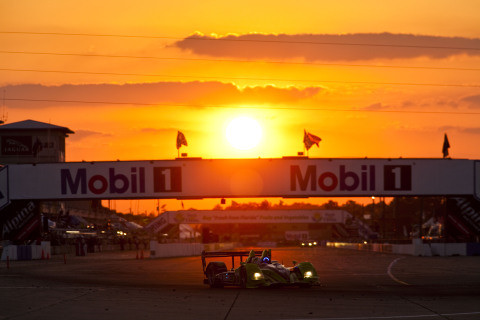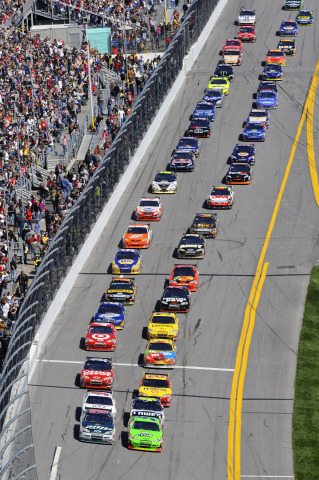The Way It Is/ Muddling throughby Gordon Kirby |
 Consternation reigned a few weeks ago among fans of the American Le Mans Series when the FIA and ACO announced next year's World Endurance Championship schedule. Eight races in eight countries are on the calendar with only one American round--the season-opener at Sebring in March. Missing from the FIA's schedule was Road Atlanta's Petit Le Mans with a 6 Hour race listed instead for October 20th in no less a place than Bahrain. Maybe when the Bahrain race almost inevitably is cancelled the FIA and ACO will turn to Road Atlanta to fill the void....
Consternation reigned a few weeks ago among fans of the American Le Mans Series when the FIA and ACO announced next year's World Endurance Championship schedule. Eight races in eight countries are on the calendar with only one American round--the season-opener at Sebring in March. Missing from the FIA's schedule was Road Atlanta's Petit Le Mans with a 6 Hour race listed instead for October 20th in no less a place than Bahrain. Maybe when the Bahrain race almost inevitably is cancelled the FIA and ACO will turn to Road Atlanta to fill the void....
ALMS fans viewed the FIA's rejection of Petit Le Mans as a slap in the face, which surely is true. But it's more than that. It's a clear signal that the FIA and ACO are aiming to attempt to follow Bernie Ecclestone's path of global growth for Formula One. Both the FIA and ACO and many of the manufacturers competing in international sports car racing want to race in countries with emerging new middle class markets. It's in those Asian and other countries, not America, where the growth in car sales is beginning to happen and will continue to occur for the foreseeable future. Also of course, like Bernie, the FIA and ACO are focusing on places where they can generate handsome sanction fees. So it's a case of the USA bedamned. Other than Sebring, the future lays elsewhere for the World Endurance Championship and that leaves the ALMS in a weakened position. How to attract more Le Mans prototypes and teams to what the FIA and ACO have boxed in as merely a national series with reduced prestige? It's a considerable challenge for the ALMS's chief Scott Atherton and its founder and spiritual leader Don Panoz.  © LAT USA The Grand-Am was created and survives at Jim France and ISC's behest and it's another sad truth for American racing that the Grand-Am and ALMS will continue on their disparate paths. Imagine how much healthier American sports car racing would be if they could find a way to work together to make the Rolex 24 at Daytona, Sebring, Petit Le Mans and all the races in between more interesting, appealing and spectacular. It's unfortunate that the sport's leadership--such as it is--remains incapable of making this happen. As I've pointed out before in this space there are no fewer than 278 auto racing sanctioning bodies in the United States and Canada running 212 different championships. To be sure many of these are local or one track-only groups but the fact is no other sport in America is remotely like auto racing's tossing sea of anarchy. Every other sport from professional and college football and basketball to major league baseball, golf, tennis, ice hockey, soccer, etc., is dominated by a single sanctioning body to which the entire sport is subservient. But not so in racing. As richly diverse as American racing is it's also our biggest curse because it's meant that there's been a continuing struggle for power in the sport with numerous sanctioning bodies coming and going over the years. Indy car and sports car racing have been particular victims of this syndrome with a consequent loss of brand identity and negotiating power with TV networks as well as overall media and fan following. Over the seventies and eighties each of the NFL, MLB, NBA, professional golf and tennis established themselves as modern, TV-driven sports, signing a series of contracts for ever more lucrative TV rights fees that skyrocketed through the nineties and the turn of the century. In racing, NASCAR and Formula One pursued essentially the same business model making those forms of the sport rich and famous. But American sports car and Indy racing were beset by power struggles, losing rather than increasing their market share and ending up with tiny slices of the TV market and little or no income from rights fees. Many other failures occurred over the same time, most notably tossing aside racing's history of innovation and the fascination with what's new or next in favor of the depredations of spec car racing. Even NASCAR has realized it went a step too far in this regard and will try to recapture some of its lost brand identities in 2013. Nor is there any doubt that the ALMS's distinctly non-spec car flavor is a key to its popularity versus the Grand-Am.  © LAT USA This year's IndyCar season ended on a cathartic note with Dan Wheldon's tragic death in Las Vegas which called into question the wisdom both of IndyCar's 'pack racing' formula and racing such cars on high-banked 1.5-mile ovals. There's hope, but not much faith, that next year's new formula will alleviate if not solve the problem. But with the drivers asking for no more races on 1.5-mile high-banked ovals Randy Bernard is struggling to pull together next year's IndyCar schedule. There are also stability and visibility problems with the new car so it's tough for the teams who are struggling to sell sponsorship to paint a positive picture. Amid all this NASCAR has emerged more than ever as the big dog of American racing. Sure it has its problems but NASCAR continues to operate a million miles ahead of any other professional form of circuit racing in America. However contrived 'The Chase for the Cup' may or may not be it certainly worked out well this year with a battle for the championship played out amid high drama through the last laps of the season. Of course NASCAR finds itself with a perfect champion in Tony Stewart. The guy is an all-round, all-American racer in the style of his hero A.J. Foyt and has a clearly defined personality that he wears on his sleeve. Nor is Stewart afraid to speak his mind and play games with the media. NASCAR couldn't hope for a better champion (Dale Jr. excepted) to help in their quest to continue to rebuild TV ratings and begin to put some bums into those empty seats that proliferate at many tracks. Meanwhile the rest of the sport cries out for leadership. It's sad that in the second century of the sport's history amid a new technology boom American auto racing is so rudderless. So many old-time fans have lost their interest in today's racing and shake their heads over the disturbing similarities between our governing classes in Washington and so much of American auto racing. Many of these folks have given up on Indy car racing but hold out hopes that the ALMS will find a way to thrive without the FIA and ACO because it's the only remaining form of American racing that appeals to them. I guess the sport will continue to muddle through but it would be awfully nice to stumble across a leader or two with the ability to transform our hopes and dreams for the future. |
Auto Racing ~ Gordon Kirby Copyright 2011 ~ All Rights Reserved |
